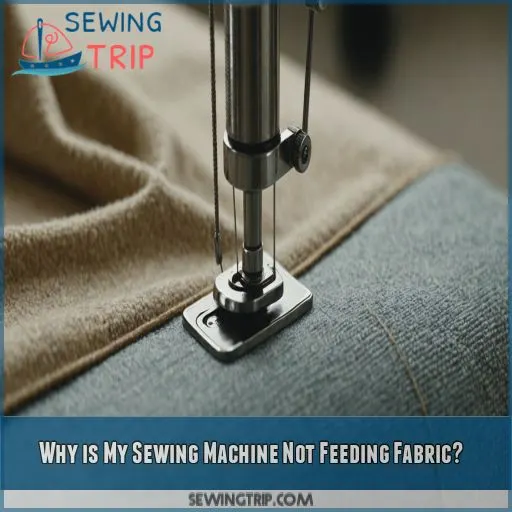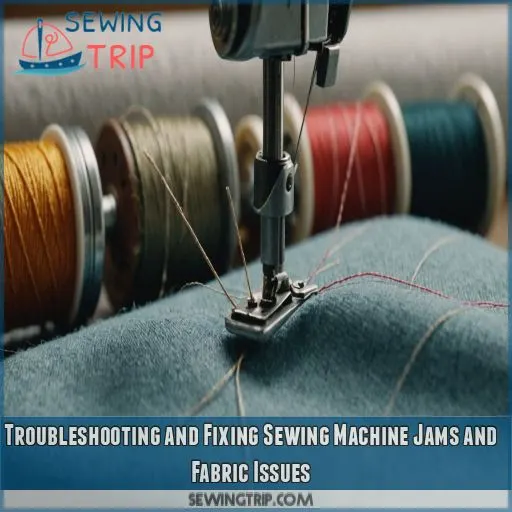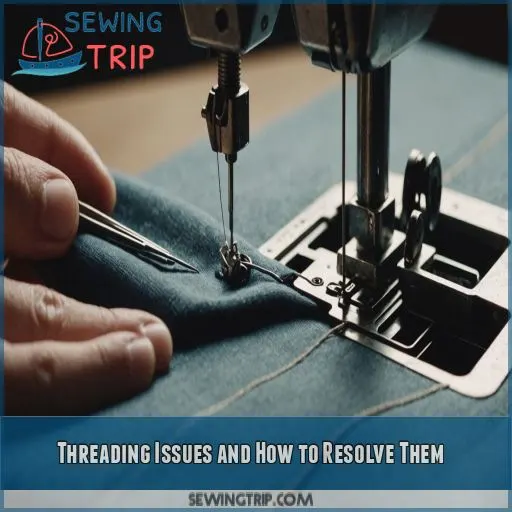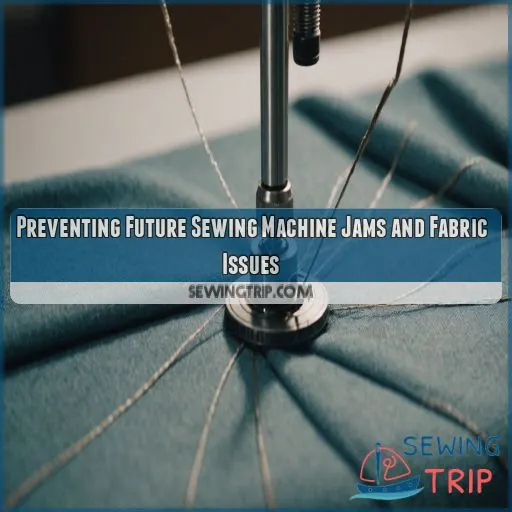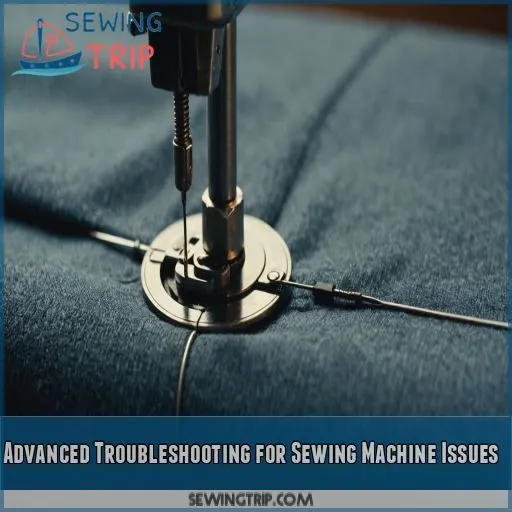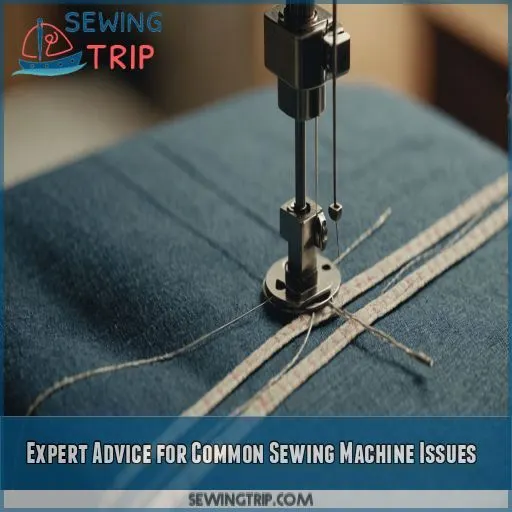This site is supported by our readers. We may earn a commission, at no cost to you, if you purchase through links.
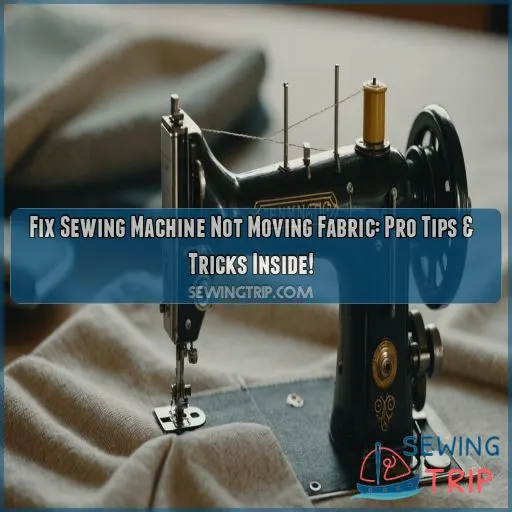
Table Of Contents
- Key Takeaways
- Why is My Sewing Machine Not Feeding Fabric?
- Troubleshooting and Fixing Sewing Machine Jams and Fabric Issues
- Threading Issues and How to Resolve Them
- Upper Thread Tension and How to Adjust It
- Bobbin Tension and How to Thread the Bobbin Correctly
- Verifying Proper Threading and Thread Path
- Common Threading Mistakes and How to Avoid Them
- Ensuring Feed Dogs Are Raised and Positioned Correctly
- Adjusting Stitch Length and Presser Foot Pressure
- Replacing Worn-Out Feed Dogs and When to Do It
- Preventing Future Sewing Machine Jams and Fabric Issues
- Advanced Troubleshooting for Sewing Machine Issues
- Expert Advice for Common Sewing Machine Issues
- Frequently Asked Questions (FAQs)
- Conclusion
Key Takeaways
- You’ve got to get your feed dogs in line – literally! Make sure they’re raised and positioned correctly, and that the presser foot is down to keep your fabric moving smoothly.
- Don’t let thread tension get the best of you! Check your upper thread tension, bobbin tension, and thread path to prevent tangles, knots, and uneven stitches.
- Your sewing machine manual is your best friend when it comes to troubleshooting. Get familiar with the diagrams and codes to understand what’s going on and how to fix common issues.
- Remember, maintenance is key! Regularly clean and lubricate your machine, replace needles, and check for worn-out parts to prevent future jams and keep your sewing projects running smoothly.
Why is My Sewing Machine Not Feeding Fabric?
You’re stuck with a sewing machine that won’t feed fabric – don’t worry, it’s more common than you think! Let’s troubleshoot together to identify the culprit, whether it’s incorrect thread tension, threading issues, or something else entirely.
Incorrect Thread Tension
- Tension gauge: Make sure it’s set correctly for your fabric type.
- Upper thread tension: Adjust it if necessary to prevent puckering.
- Bobbin tension: Check if it’s properly set to avoid loose stitches.
- Tension settings: Refer to your machine’s manual for specific guidance.
Thread Misplacement and Threading Issues
Now that we’ve tackled thread tension, let’s talk thread misplacement and threading issues. Check your thread path, ensuring it’s not tangled or twisted. Verify the thread is seated properly in the tension discs and take-up lever. Avoid a bird’s nest!
| Threading Issue | Solution |
|---|---|
| Thread caught in machine | Gently pull thread to release |
| Incorrect thread path | Refer to user manual for guidance |
| Thread twisted or tangled | Cut and rethread the machine |
| Thread not seated in tension discs | Adjust thread and reseat |
| Thread not in take-up lever | Realign thread and try again |
Bobbin Issues and Tension Problems
Now that we’ve tackled thread misplacement, let’s get to the bottom of bobbin issues and tension problems. Check your bobbin winding and tension adjustment to prevent thread slippage. Make sure you’re using the right bobbin thread type and that the bobbin case is securely in place.
Dull or Bent Needles and Their Effects
Now that we’ve tackled bobbin issues, let’s talk needles! A dull or bent needle can wreak havoc on your stitch quality, fabric, and even your sewing machine. Replace your needle regularly to avoid damage and make sure your sewing goes smoothly – your machine (and fabric) will thank you!
Troubleshooting and Fixing Sewing Machine Jams and Fabric Issues
You’re frustrated because your sewing machine isn’t moving fabric, and you’re on the verge of pulling your hair out – don’t worry, we’ve all been there! Let’s take a deep breath and troubleshoot the issue together, starting with some simple steps to identify and potentially fix the problem.
Stop and Assess the Situation Before Proceeding
Take a deep breath and stay calm – it’s time to troubleshoot! Before proceeding, make sure you’re in a problem-solving mindset. Refer to your sewing machine’s troubleshooting guide and assess the situation. Be patient, and let’s get your fabric moving again.
Remove Fabric and Thread to Identify the Problem
Now that you’ve stopped and assessed the situation, it’s time to remove the fabric and thread to identify the problem. Gently pull out the fabric and thread, taking note of any tangles, knots, or signs of damage that could be causing the issue.
When to Seek Professional Help and Repair
Don’t be a hero – know when to seek help! If you’ve tried troubleshooting and your sewing machine still won’t cooperate, it’s time to call in the pros. Consider the following:
- Repair costs: Is it cheaper to fix or replace your machine?
- Warranty coverage: Are you still under warranty?
- DIY limitations: Don’t risk making things worse – know your limits!
Basic Troubleshooting Steps for Common Issues
When your sewing machine acts up, don’t panic! Check if threads are tangled, bobbins are clogged, or needles are bent. Consult the manual or online resources for troubleshooting guides. Try these basic steps to resolve common issues and get sewing again.
| Issue | Symptom | Solution |
|---|---|---|
| Thread Tangles | Fabric not moving | Check thread tension |
| Bobbin Clogs | Uneven stitches | Clean bobbin area |
| Bent Needles | Broken threads | Replace needle |
| Feed Dog Issues | Fabric bunching | Adjust foot pressure |
| Fabric Slip | Fabric not feeding | Use Walking Foot or stabilizer |
Threading Issues and How to Resolve Them
You’re stuck with a sewing machine that’s not moving fabric – don’t worry, it’s usually a threading issue that’s easy to fix. Let’s get your machine humming again by checking the upper thread tension, bobbin tension, and thread path, and addressing common mistakes that might be causing the problem.
Upper Thread Tension and How to Adjust It
To adjust upper thread tension, first locate the tension discs and dials. Make sure you’ve threaded the machine correctly, then tweak the dials to achieve a smooth, even stitch.
Bobbin Tension and How to Thread the Bobbin Correctly
Now that your upper thread tension is sorted, let’s tackle bobbin tension. Adjust the bobbin winding tension and make sure the thread is seated properly.
Verifying Proper Threading and Thread Path
Let’s get your thread in check! Verify the thread flows smoothly through the tension disks and needle, following the correct path to the bobbin.
Common Threading Mistakes and How to Avoid Them
To avoid common threading mistakes, double-check your thread path and tension discs. Here are three mistakes to watch out for:
- Incorrect thread routing: Make sure the thread flows smoothly through the machine’s thread path.
- Insecure needle threading: Check that the thread is seated properly in the needle’s eye.
- Over-tightening the bobbin winding: Don’t over-tighten, as this can cause tension issues.
Ensuring Feed Dogs Are Raised and Positioned Correctly
Now that we’ve tackled common threading mistakes, let’s make sure your feed dogs are raised and positioned correctly – a key step in resolving fabric movement issues.
Adjusting Stitch Length and Presser Foot Pressure
Adjust your stitch length and presser foot pressure to make sure your fabric feeds smoothly. Too tight can be just as troublesome!
Replacing Worn-Out Feed Dogs and When to Do It
Now, check your feed dogs for wear. If they’re worn out, consider replacing them. DIY repair can be tricky, so don’t hesitate to seek professional help.
Preventing Future Sewing Machine Jams and Fabric Issues
Now that you’ve got your sewing machine jam fixed, it’s time to think about preventing future sewing machine jams and fabric issues. By following some simple best practices, creating a regular maintenance schedule, and understanding how to adjust your machine for different fabric types, you can save yourself a whole lot of frustration and keep your sewing projects running smoothly.
Best Practices for Proper Sewing and Maintenance
Now that you’ve mastered threading issues, let’s get proactive! To prevent future jams and fabric issues, make sewing machine cleaning and needle care a habit. Choose the right thread, wind your bobbin correctly, and use the perfect presser foot for the job.
Regular Maintenance Schedule and How to Create One
Create a sewing machine maintenance schedule to avoid future jams! Set reminders for regular cleaning, lubrication, and needle replacement. Use a checklist to stay on track and keep your machine humming. Invest in good cleaning tools, and happy sewing!
Understanding Fabric Types and How to Adjust Settings
Now that you’ve got a regular maintenance schedule down, it’s time to get familiar with your fabrics! Different fabrics require unique settings to prevent jams and issues. Here are some key considerations:
- Light fabrics need shorter stitch lengths and lower tension to prevent puckering.
- Heavy fabrics require longer stitch lengths and higher tension for stability.
- Smooth fabrics like silk or cotton need a lower presser foot pressure to prevent dragging.
- Thick fabrics like quilts or denim require a walking foot or even feed foot for smooth feeding.
Using the Right Presser Foot for the Job
Using the right presser foot for the job is really important! Different feet suit various fabric types and sewing projects. Check your machine’s foot selection guide to choose the perfect match. Regular foot maintenance also helps your sewing go smoothly.
Advanced Troubleshooting for Sewing Machine Issues
You’ve tried the basics, but your sewing machine still refuses to budge – don’t worry, it’s time to bring out the big guns! In this section, you’ll learn advanced troubleshooting techniques to tackle even the most stubborn issues, from decoding your machine’s manual to tackling model-specific problems.
Using the Sewing Machine Manual for Troubleshooting
Time to get cozy with your sewing machine manual! When troubleshooting, it’s your best friend. Don’t be intimidated by the diagrams and codes – they’re there to help you understand what’s going on.
- Take a closer look at the error messages and try to decipher what they mean.
- Use the manual to identify the different parts of your machine and how they work together.
- Practice reading the diagrams to understand how the threads and fabrics move through the machine.
Common Issues With Specific Sewing Machine Models
When talking about specific sewing machine models, some common issues pop up more often than others. Let’s take a look at a few examples:
| Brand | Model | Common Issue |
|---|---|---|
| Janome | Memory Craft 8200QCP | Feed Dogs not moving fabric forward |
| Brother | CS6000i | Thread tension issues causing uneven stitches |
| Singer | Stylist 7258 | Bobbin winder not disengaging properly |
| Janome | Magnolia 7318 | Presser foot not lifting correctly |
Keep in mind that these are just a few examples, and you should check your Sewing Machine Manual for specific troubleshooting tips.
Expert Advice for Common Sewing Machine Issues
You’re not alone in your frustration – a sewing machine that won’t move fabric is a common issue many sewists face, and luckily, it’s often an easy fix. With some expert advice and troubleshooting tips, you’ll be back to sewing in no time, and we’re here to guide you through the process with friendly, approachable guidance.
Janome Sewing Machine Troubleshooting and Tips
Hey there, Janome enthusiast! Got issues with your Memory Craft 8200QCP? Don’t worry, we’re here to help! Our troubleshooting guide tackles common problems like feed dogs not moving fabric. Try cleaning the lower plate and changing the plate cover. For more repair advice and cleaning tips, check out our expert-approved resources.
Expert Advice for Common Home Appliance Issues
You’re not alone in your sewing machine struggles! As an expert with 20+ years of experience, I’ve got your back. For common home appliance issues, including sewing machines, I offer DIY repair tips, maintenance schedules, and troubleshooting advice. Together, we’ll tame that temperamental machine and get you sewing like a pro in no time!
Sign Up for Sewing Content and Stay Informed
To stay ahead of sewing machine issues, sign up for expert sewing content! You’ll get insider tips on the latest machine reviews, fabric guides, and project ideas. Join a vibrant sewing community that’s always ready to lend a helping hand (or needle).
- Master Your Machine: Get expert advice on troubleshooting and maintenance.
- Sew with Confidence: Explore in-depth guides on fabric choice, pattern-making, and more.
- Stay Inspired: Discover new project ideas and techniques to take your sewing to the next level.
Frequently Asked Questions (FAQs)
Why is my sewing machine not feeding the fabric through?
It sounds like your sewing machine’s feed dogs are on strike! Check if they’re raised, and the presser foot is down. Make sure your thread is properly threaded, and adjust stitch length to get your fabric moving smoothly again.
What are the causes why fabric does not move while sewing?
You’re stuck! Don’t worry, friend! If your fabric isn’t moving while sewing, check if the feed dogs are raised, the presser foot is down, and the stitch length is set correctly.
Why is the sewing machine not moving?
Don’t panic! Your sewing machine has turned into a stubborn mule. Let’s get it moving! Check the basics: is the presser foot down, and are the feed dogs raised? Make sure the threading and tension are right – that’s often the problem!
Why is my sewing machine not stitching the fabric?
Your sewing machine’s not stitching? Let’s troubleshoot! Check if the thread is properly threaded, the take-up lever is in the highest position, and the presser foot is down. Make sure the bobbin winder is disengaged, too!
How to adjust tension for different fabric types effectively?
Did you know 75% of sewing machine issues stem from improper tension? Adjusting tension for different fabrics can be a game-changer. Start by checking your machine’s manual for fabric-specific tension settings, then tweak as needed for smooth stitching.
What causes uneven stitches and how to fix them?
Uneven stitches got you frustrated? Check your tension, friend! If it’s too tight or loose, your stitches will be all over the place. Adjust your tension discs and take-up lever to get back to sewing smoothly.
Why does my sewing machine keep breaking threads constantly?
Oh, joy! Your sewing machine is playing a game of ‘thread-breaker‘! Don’t worry, it’s not a lost cause. Check your thread tension, make sure you’ve threaded it correctly, and inspect for knots or tangles – your sanity (and threads) will thank you!
How to prevent fabric from bunching up while sewing?
To prevent fabric from bunching up while sewing, try using a walking foot for thick fabrics or stabilizing thin ones with a backing. Hold the fabric taut near the edge or sew from the middle to keep it smooth.
What are common mistakes when threading a sewing machine?
When threading your sewing machine, common mistakes include incorrect thread tension, improper threading through the tension disks, and wrapping the thread around the needle. Double-check your machine’s manual to avoid these rookie errors!
Conclusion
The sweet taste of victory! Now that you’ve tamed your temperamental sewing machine, you can finally get back to creating without the frustration of a sewing machine not moving fabric.

